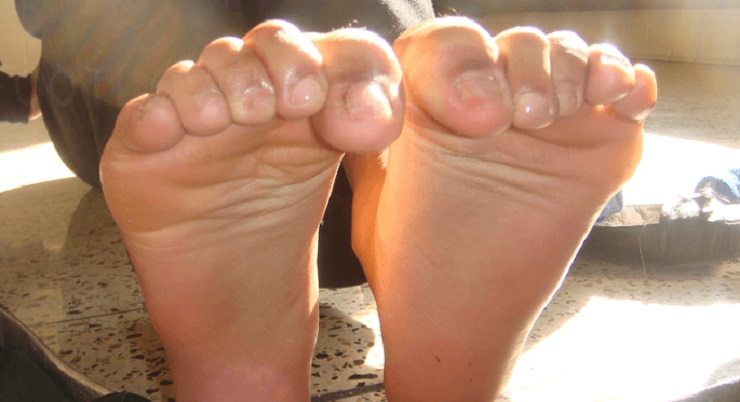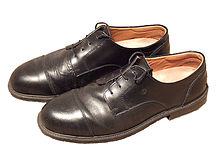
Your toes may play a critical role when it comes to healing plantar fasciitis pain. In fact, toe extensor foot muscle stretches could prove to be the most important exercises you will ever hear about.
Why do I say this? As noted in the article What is Plantar Fasciosis, when you look at the feet of a young child you will see that their feet are widest at the end of their toes. This is the normal posture of human feet. It provides us with appropriate foot strength and stability.
This is often no longer true for those of us who have worn shoes most every day during our lifetime. If you are a long-term shoe-wearer like me you may find that the widest part of your feet are at the balls of your feet and your outside toes are bent inward.
Blame the Shoes
Unfortunately, our modern-day shoes train our feet to change shape. They not only squeeze our toes, pushing both the big and small toe inward, they also pull our toes upward.
These changes in shape tend to stress the muscles that allow us to wiggle our toes. Over time, the stressed foot muscles may start to pinch an artery that runs from the big toe to the heel area, reducing the flow of blood near the areas where plantar fasciitis/fasciosis pain occurs. The result is that some of the cells that are not receiving enough blood may begin to deteriorate or die.
According to The Gait Guys, “Digit extensor tightness is rampant in our society. We have been in shoes … for so long that our flexors and foot intrinsic muscles have become pathologically weak.”
For this reason, we need to begin to build up the muscles that have become weakened due to our modern-day lifestyle.
Toe Stretching Exercises
In the Exercises for Toes post a number of exercises involving the toes were described. These were aimed at stretching and strengthening the muscles and plantar fascia tissue in the bottom of the foot.
Remember that strengthening your feet can lead to improved functioning of your feet, better posture, and may help prevent reoccurrence of plantar fasciitis/fasciosis or other foot injuries.
The digit extensor muscle tightness issue requires a similar but slightly different exercise than those in the previous post. Like the others, this exercise is toe-related. It is called the Toe Extensor stretch because it focuses on the extensor muscles.
So, what are these toe extensor muscles anyway? They are thin muscles located in the top part of the foot that help control the movement of our toes.
Essentially, there are four extensor muscles, two that help control the movement of the big toe, one that works with the other four toes, and a fourth that also helps with movement of the little toe.
If you feel pain or tightness in the top part of your foot it could very well be related to tight extensor muscles. As noted earlier, if these muscles are stressed, they may be restricting blood flow to the area near the heel, contributing to the pain of plantar fasciitis/fasciosis.
The following video, by Dr. Ray McClanahan, discusses the purpose of and demonstrates the Toe Extensor stretch:
It is very important to remember that stretching is not intended to cause pain. While stretching, you want to feel a slight pull on the muscle. Don’t go so far as to cause harm to yourself, however.
Also, recognize that the length of time that you are told to hold a stretch is a guideline. You may want to hold a specific stretch longer than 20 seconds, which is ok, but be sure to repeat the stretch 3-4 times each session to help build strength and flexibility.
Similar Stretches
Other names for this type of stretch are the Great Toe Extensor stretch and the Great Toe Extension stretch. Essentially, they are all the same stretch, but these provide alternative ways to stretch the extensors other than the method shown in the video.
For example, the picture here shows how you can perform this type of stretch while standing up. Simply do the following:
- Begin by moving your foot back about 6 inches.
- Curl your toes under your foot as in the picture.
- Next, bend your foot back over the toes until you start to feel the muscles on the top of your foot being stretched.
- To increase the stretch, push your ankle forward while keeping your toes curled. If you feel a cramp developing in your arch area, release the stretch and try again.
Obviously, the sitting or standing methods can both work. Try it both ways and see which one feels best for you.
Questions or Comments
When you look at your feet do you see the inward bending of your big and little toes? When you attempt this exercise can you feel the tightness in your extensor muscles?
If you have worked with this exercise previously, has it helped you?
Please provide your thoughts and insights in the comment area below.

Hi Allyn I used to work with feet and I saw how disabling plantar fasciitis can be. Your clear instructions on how to eliminate pain by toe extensor foot muscle stretches is a great way to help the condition.
Thanks Annie, I appreciate your comment. Since you worked with feet, are there any particular exercises or treatments that you understood to be most helpful to people suffering with fasciitis? We know that no one thing will eliminate the problems for everyone.
Hi Allyn I used to first advise women to change out of their high heels! Then depending on where the pain was most felt, if arch fatigue, then I used to hand make arch supports out of dense chiropodist’s foam. These could be built up quite accurately to the shape of the patient’s arch and were effective in relieving pain in many cases. For the heels, again I used to use a foam pad, but being careful to eliminate the possibility of pain from a stress fracture. Exercises, as you have said in this article, were also very useful.
That’s terrific, Annie. Thanks for replying so quickly to my question. So, custom orthotics were a key treatment, plus you had them go with better shoes (if necessary) and helpful exercises. I really appreciate your input!
Very good job. Excellent content. Great visuals.
Thanks Jeff. I see you have a site dedicated to getting rid of pain also. As I continue to age, I certainly can feel how my body is losing its strength and flexibility. I started karate about 9 months ago and it is providing me with great exercise but it is almost impossible to keep up with my son and my grandsons.
Obviously, our body is one incredible system such that pain anywhere affects how other parts can function. I look forward to exchanging a bit with you over time.
This is exactly what I have and unsure of how to ease the pain. I never knew there were stretches possible for this area of the foot. I will be giving this a try for the next week or so and see how it goes.
Paul
I’m happy to know that this connected with your situation, Paul. I really didn’t know much about the extensor muscles until I started researching exercises. I’ve had times, at night, when I get a cramp in the big toe extensor. That is quite painful but I’ve learned what I need to do to help it relax.
Come back after trying out this exercise and let us know whether they have helped you at all.
Hi Allyn, great work. I write you from Italy, i’m going crazy with my abductor of big toe. I am (was) a runner but i can’t restart because i feel pain on my arch area in correspondence with the big toe abductor. It’s not a plantar fasciitis. What kind of exercises do you advice me?
Thanks
Hi Alessandro. I had to do a bit of research to better understand about the abductor. In some ways, it does react to similar treatments as the plantar fascia, though it is significantly different in its function. The Sports Injury Clinic website appears to be a very credible site to better understand how you might attempt to overcome this issue. Like the fascia, early treatment could include rest, cold therapy (similar to ), taping, and ibuproen. You may have tried all of these already. Massage, such as could be helpful. Don’t forget regular attention with stretches for the calf and fascia, however, and be sure to wear appropriate footwear. I’d suggest you also be careful of walking too much on hard floors, particularly if barefoot. Remember, I’m not a doctor, so this is just practical advice. I hope this may help in some way.